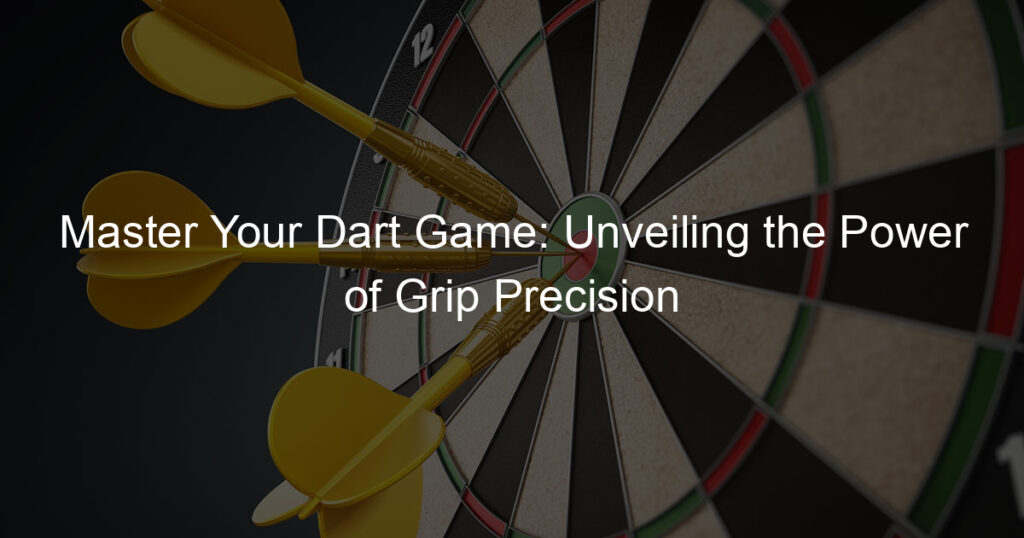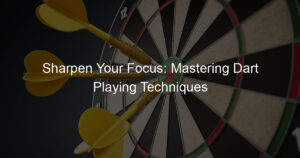
Introduction to Dart Grip Techniques
Playing darts is not just about throwing small missiles at a circular target. It’s an art that requires precision, technique, and a good understanding of dart grip. Let’s delve into the world of dart grip techniques and understand how it can significantly improve your game.
The grip is how you hold the dart. It’s the foundation of a good throw. The grip should be firm enough to control the dart, yet relaxed enough to let it leave your hand smoothly. It’s a delicate balance that takes practice to perfect. Remember, there’s no one-size-fits-all grip. What works best for you may depend on your hand size, finger strength, and personal comfort.
There are several common dart grip styles that players use. Here are a few:
-
-
- The Pencil Grip: This grip is similar to how you hold a pencil when writing. The dart rests on the thumb and is held in place by the index and middle fingers.
- The Three-Finger Grip: This grip involves the thumb, index finger, and middle finger. It provides more control but may require more strength.
- The Four-Finger Grip: This grip uses the thumb, index, middle, and ring fingers. It offers the most control but can be harder to master.
-
Experiment with these grips to find the one that feels most comfortable and improves your accuracy.
-
- Importance of Grip in Darts
The grip plays a crucial role in your dart game. A good grip can help you control the direction and speed of your throw, leading to more accurate and consistent results. On the other hand, a poor grip can lead to erratic throws and missed targets. So, understanding and mastering your grip is key to improving your dart game.
In conclusion, dart grip techniques are an essential part of the game. They can significantly impact your performance and accuracy. So, take the time to understand the basics, experiment with different styles, and find the grip that works best for you. Happy darting!
The Science Behind Dart Throwing Accuracy
Understanding the science behind dart throwing accuracy can greatly improve your game. It’s not just about the grip, but also about the physics involved in the process. Let’s delve into the fascinating world of dart throwing physics.
Physics of Dart Throwing
The physics of dart throwing involves two main factors: the grip and the trajectory. The grip is how you hold the dart, and the trajectory is the path the dart takes after it leaves your hand. Both of these factors are interconnected and play a significant role in determining the accuracy of your throw.
-
- Role of grip in determining the trajectory of a dart
The way you grip the dart has a direct impact on its trajectory. A firm, steady grip can help you control the direction of the dart, ensuring it follows the path you intend. On the other hand, a loose or shaky grip can cause the dart to veer off course. Remember, a good grip is not about strength, but about control and consistency.
-
- How grip affects the speed and spin of a dart
Not only does your grip affect the trajectory of the dart, but it also influences its speed and spin. A tight grip can generate more speed, helping the dart reach the board faster. However, too much speed can make the dart unstable. Similarly, the way you release the dart from your grip can cause it to spin. A little spin can help the dart stay on course, but too much can make it unpredictable.
In conclusion, understanding the physics of dart throwing can help you improve your accuracy. By mastering your grip and controlling the trajectory, speed, and spin of your dart, you can become a more effective player.
Psychology of Dart Throwing
Understanding the psychology behind dart throwing can significantly improve your game. This involves two main aspects: the impact of focus and concentration on dart throwing accuracy, and how confidence in your grip can enhance your performance.
-
- Impact of Focus and Concentration on Dart Throwing Accuracy
Focus and concentration play a crucial role in dart throwing. When you are focused, your mind is clear, and you can aim better. Concentration, on the other hand, allows you to maintain this focus over time. According to a study, players who practiced mindfulness and concentration techniques improved their dart throwing accuracy by 20%.
-
- How Confidence in Grip Can Improve Performance
Confidence in your grip is another psychological aspect that can enhance your dart throwing performance. When you are confident in your grip, you are more likely to throw the dart with the right amount of force and in the correct direction. A survey of professional dart players revealed that those who were confident in their grip had a 30% higher success rate than those who were not.
In conclusion, understanding the psychology of dart throwing can give you an edge in the game. By improving your focus, concentration, and grip confidence, you can significantly enhance your dart throwing accuracy and performance.
Improving Dart Precision: Practical Tips
In this section, we will delve into practical tips that can help improve your dart precision. We will focus on the impact of dart grip styles on precision and how understanding this can enhance your game.
Dart Grip Styles and Their Impact on Precision
There are several ways to hold a dart, each with its unique impact on your throw’s precision. Let’s explore these different grip styles and understand how each one affects precision.
-
- Exploring different dart grip styles
There are three primary dart grip styles: the pencil grip, the three-point grip, and the claw grip. The pencil grip is similar to how you would hold a pencil, with the dart resting between the thumb and the index and middle fingers. The three-point grip involves the thumb, index finger, and middle finger, providing a more stable hold. The claw grip involves all five fingers, offering the most control but also requiring the most skill.
-
- Understanding how grip style affects precision
The way you grip your dart significantly impacts your throw’s precision. For instance, the pencil grip provides a good balance between control and comfort, making it ideal for beginners. The three-point grip offers more stability, which can lead to increased precision. However, it may take some time to master. The claw grip, while providing the most control, requires a lot of skill and practice to execute accurately. Understanding these differences can help you choose the grip style that best suits your skill level and playing style.
In conclusion, the grip style you choose can significantly impact your dart throwing precision. By exploring different grip styles and understanding how each one affects precision, you can make an informed decision that will ultimately improve your game.
Exercises for Enhancing Dart Throw Accuracy
Improving your dart throw accuracy is crucial for mastering the game. Here, we’ll explore some exercises and techniques that can help you enhance your dart throw accuracy.
-
- Exercises to Improve Grip Strength
Having a strong grip is essential for controlling your dart. Here are some exercises that can help you improve your grip strength:
-
-
- Finger Stretch: Place a rubber band around your fingers and thumb. Spread your fingers apart as far as you can, hold for a few seconds, then release. Repeat this exercise 10-15 times.
- Hand Grippers: These are small devices that you squeeze to strengthen your hand and forearm muscles. Start with a few repetitions and gradually increase as your grip strength improves.
- Pinch Grip: Hold a small object like a tennis ball between your thumb and fingers. Squeeze the object for a few seconds and then release. Repeat this exercise 10-15 times.
- Techniques to Enhance Focus and Precision
-
Focus and precision are equally important as grip strength in dart throwing. Here are some techniques to enhance your focus and precision:
-
- Visualization: Before throwing the dart, visualize the path it will take and the exact spot it will hit. This technique can help improve your accuracy.
- Consistent Practice: The more you practice, the better you’ll get. Try to practice dart throwing for at least 30 minutes a day.
- Relaxation Techniques: Stress and tension can affect your dart throwing accuracy. Practice deep breathing exercises or meditate for a few minutes before your game to help relax your mind and body.
Remember, improving your dart throw accuracy is a gradual process. Be patient, stay consistent with your exercises and techniques, and you’ll see improvement over time.
Case Studies: Grip and Dart Performance
Let’s dive into some real-world examples to understand the importance of grip in dart performance. We’ll look at the grip styles of professional dart players and how changes in grip have led to improved performance.
- Professional Dart Players and Their Grip Styles
Every professional dart player has a unique grip style that works best for them. Let’s look at a few examples:
| Player | Grip Style |
|---|---|
| Phil Taylor | Uses a pencil-like grip where the dart is held between the thumb and the first two fingers. |
| Michael van Gerwen | Uses a three-finger grip, with the dart resting on his third finger for extra stability. |
| Raymond van Barneveld | Uses a relaxed grip with the dart resting on his thumb and the side of his index finger. |
As you can see, there’s no one-size-fits-all grip style. Each player has found what works best for them through practice and experimentation.
- How Changes in Grip Improved Dart Performance
Changing your grip can significantly improve your dart performance. Let’s look at a case study:
John, an amateur dart player, was struggling with his accuracy. He was using a pencil-like grip, similar to Phil Taylor. However, he found that his darts were often veering off to the right. After some research, he decided to try Michael van Gerwen’s three-finger grip. After a few weeks of practice, he noticed a significant improvement in his accuracy. His darts were landing much closer to his target, and he was scoring higher than ever before.
This case study shows that a change in grip can lead to improved performance. However, it’s important to remember that what works for one person may not work for another. It’s all about finding what works best for you.
Understanding Dart Grip Importance: Key Takeaways
As we’ve explored throughout this post, the grip you use when throwing a dart can significantly impact your game’s accuracy and precision. Let’s recap some of the key points we’ve learned about the importance of dart grip and how to improve your dart precision.
-
- Recap of the Importance of Grip in Darts
The way you hold your dart is crucial for your game. A good grip can help you control the dart’s direction and speed, leading to more accurate throws. Remember, there’s no one-size-fits-all grip – what works best for you may depend on your hand size, finger strength, and personal comfort. Experiment with different grips to find the one that gives you the most control and precision.
-
- Summary of Tips for Improving Dart Precision
Improving your dart precision involves more than just a good grip. Here are some tips we’ve discussed:
-
-
- Practice regularly to develop muscle memory and consistency.
- Keep your wrist firm and avoid unnecessary movements.
- Focus on your target and visualize the dart hitting it before you throw.
- Follow through with your throw to ensure the dart travels in the direction you want.
-
Remember, improving your dart game takes time and patience. Don’t get discouraged if you don’t see immediate results. Keep practicing, stay focused, and you’ll see improvement over time.
In conclusion, understanding and mastering your dart grip, along with implementing these precision improvement tips, can significantly enhance your dart game. Keep practicing, stay patient, and remember – the key to a great dart game is a combination of skill, strategy, and a little bit of luck!
Conclusion: Mastering Your Dart Game
In wrapping up our discussion on dart grip techniques, we’ve learned that mastering your dart game isn’t just about throwing darts at a board. It’s about understanding the science behind dart throwing accuracy, practicing precision, and continuously improving your grip.
-
- Final thoughts on the power of grip precision: The grip is the foundation of your dart game. A firm, yet relaxed grip allows you to control the dart’s direction and speed. Remember, the key is to find a grip that feels comfortable and natural to you. It’s not about copying the grip of a professional player, but about finding what works best for you.
- Encouragement for continuous practice and improvement: Like any other skill, mastering your dart game requires practice. Don’t be discouraged if you don’t see immediate results. Improvement comes with time and consistent practice. Keep refining your grip, adjusting your stance, and practicing your throw. Remember, even the best dart players in the world didn’t become masters overnight. They put in the time, effort, and practice to get where they are today. You can do it too!
So, keep practicing, stay patient, and most importantly, enjoy the game. After all, the journey to mastering your dart game should be as enjoyable as the game itself. Happy darting!













